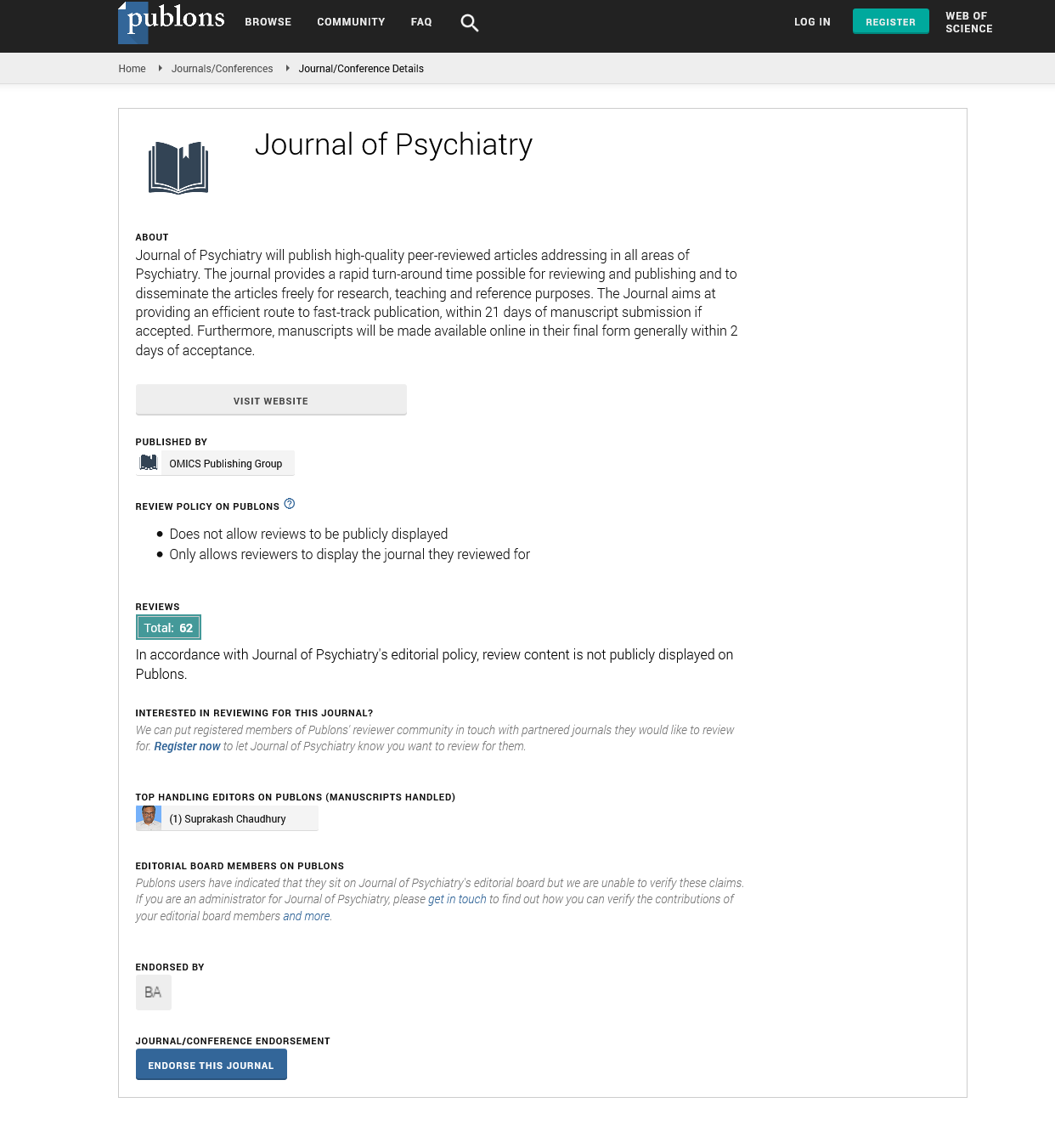Indexed In
- RefSeek
- Hamdard University
- EBSCO A-Z
- OCLC- WorldCat
- SWB online catalog
- Publons
- International committee of medical journals editors (ICMJE)
- Geneva Foundation for Medical Education and Research
Useful Links
Share This Page
Open Access Journals
- Agri and Aquaculture
- Biochemistry
- Bioinformatics & Systems Biology
- Business & Management
- Chemistry
- Clinical Sciences
- Engineering
- Food & Nutrition
- General Science
- Genetics & Molecular Biology
- Immunology & Microbiology
- Medical Sciences
- Neuroscience & Psychology
- Nursing & Health Care
- Pharmaceutical Sciences
Perspective - (2024) Volume 27, Issue 5
Neurobiological Insights into Depression from a Functional MRI Perspective
Foteini Kelekis*Received: 30-Aug-2024, Manuscript No. JOP-24-27411; Editor assigned: 02-Sep-2024, Pre QC No. JOP-24-27411; Reviewed: 16-Sep-2024, QC No. JOP-24-27411; Revised: 23-Sep-2024, Manuscript No. JOP-24-27411; Published: 30-Sep-2024, DOI: 10.35248/2378-5756.24.27.708
Description
Depression is a complex and multifaceted mental health disorder that affects millions of individuals worldwide, often leading to significant impairment in daily functioning and overall quality of life. The neurobiological mechanisms of depression have garnered considerable attention in recent years, particularly with advancements in neuroimaging techniques such as functional magnetic resonance imaging. This systematic review seeks to explore the neurobiological correlates of depression, providing insights from fMRI studies that illuminate the complex relationships between brain activity, structure and the symptomatic expression of depression. Functional MRI, a non-invasive imaging technique that measures brain activity by detecting changes in blood flow, has revolutionized our understanding of the neural mechanisms associated with depression. Studies utilizing fMRI have identified a range of neural circuits that are consistently implicated in the pathology of depression. One of the most frequently observed patterns involves dysregulation in the Default Mode Network (DMN), a network of brain regions that is active during rest and mind-wandering but shows altered activation patterns in depressed individuals. Specifically, hyperactivity in the DMN, particularly in the medial prefrontal cortex and posterior cingulate cortex, has been associated with rumination a common cognitive symptom of depression. This hyperactivity may contribute to the persistence of negative thought patterns, perpetuating the cycle of depressive symptoms.
In addition to the DMN, the emotional regulation network, including the prefrontal cortex, amygdala and Anterior Cingulate Cortex (ACC), has been shown to exhibit altered connectivity in individuals with depression. The prefrontal cortex, responsible for higher-order cognitive functions and emotional regulation, often displays hypoactivity in depressed individuals, leading to difficulties in modulating emotional responses. Conversely, the amygdala, which plays a essential role in emotional processing, tends to be hyperactive, heightening sensitivity to negative stimuli. This dysregulation in the emotional regulation network underscores the neurobiological basis of mood disturbances and the challenges faced by individuals with depression in managing their emotional experiences. Moreover, fMRI studies have highlighted the significance of reward processing in depression. The ventral striatum, a key region involved in the brain's reward circuitry, often shows reduced activation in response to positive stimuli among individuals with depression. This blunted response to rewards may contribute to anhedonia the inability to experience pleasure which is a core symptom of depression. Understanding the neural correlates of reward processing offers valuable insights into the motivational deficits observed in depressed individuals and suggests potential targets for therapeutic intervention. Another critical area of investigation involves the impact of chronic stress on the neurobiology of depression. Chronic stress is a well-established risk factor for the development of depressive disorders and fMRI studies have elucidated the ways in which stress affects brain structure and function. For example, alterations in the hippocampus, a region associated with memory and emotional regulation, have been documented in individuals with a history of chronic stress and depression. Reduced hippocampal volume is often observed in depressed patients, suggesting a potential link between stress exposure, neuroplasticity and the manifestation of depressive symptoms. Furthermore, functional connectivity analyses have revealed disruptions in the hippocampal-prefrontal and hippocampalamygdala pathways, indicating that stress-related changes in these circuits may contribute to the vulnerability to depression.
The integration of fMRI with other neuroimaging techniques, such as structural MRI and Diffusion Tensor Imaging (DTI), has also enriched our understanding of the neurobiological correlates of depression. For instance, structural MRI studies have identified alterations in gray matter volume in regions such as the prefrontal cortex and amygdala in depressed individuals. Similarly, DTI studies have shown disrupted white matter integrity in key neural pathways, further elucidating the structural changes associated with depression. By combining these modalities, researchers can develop a more comprehensive picture of the neural landscape of depression, linking functional abnormalities with structural correlates. Despite the wealth of information provided by fMRI studies, there are still several limitations and challenges in the field. Variability in study designs, sample sizes and methodologies can lead to inconsistencies in findings. Additionally, the heterogeneous nature of depression poses challenges in establishing clear neurobiological markers, as different subtypes of depression may exhibit distinct neural profiles. Future research should focus on longitudinal studies that track changes in brain activity and structure over time, as well as investigations into how these changes relate to treatment response and symptom remission.
In conclusion, functional MRI studies have provided critical insights into the neurobiological correlates of depression, elucidating the intricate interplay between brain function and depressive symptoms. Dysregulation in key neural networks, including the default mode network and emotional regulation circuitry, alongside alterations in reward processing and structural changes associated with chronic stress, all contribute to our understanding of this complex disorder. Continued research in this area is essential for developing targeted interventions and improving treatment outcomes for individuals suffering from depression, ultimately paving the way for more personalized and effective therapeutic approaches.
Citation: Kelekis F (2024). Neurobiological Insights into Depression from a Functional MRI Perspective. J Psychiatry. 27:708.
Copyright: © 2024 Kelekis F. This is an open-access article distributed under the terms of the Creative Commons Attribution License, which permits unrestricted use, distribution, and reproduction in any medium, provided the original author and source are credited.

